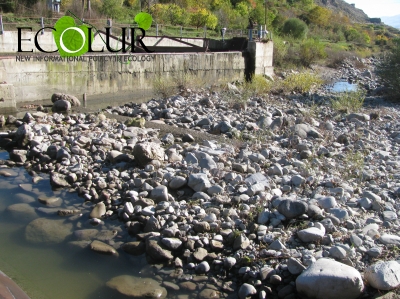

EcoLur
Whether Armenia has prerequisites for the development of sustainable energetic system? Below we present the viewpoint of “EcoLur” Informational NGO, which has been raised at the “Sustainable Energy Systems in the South Caucasus: Reality or Illusion?” discussion held at the American University of Armenia with the support of Heinrich Böll Foundation (Germany).
Currently, the Public Services Regulatory Committee (PSRC) has issued 173 licenses for SHPPs with the total capacity of 305 570 kWt and estimated production of 857.2 mln kWt*hour per year. According to the presented data, the SHPPs shall produce 9% of all the electricity produced in the country. If the total amount of the produced electricity is recalculated, the contribution of the SHPPs will decrease up to 7.9%.
Overload on the river – the example of the Yeghegis River.
The Yeghegis Rivr is a vivid example, where you can observe SHPP-related problems. The Yeghegis River flows in the Vayots Dzor Region and has several small brooklets. 17 SHPPs have been constricted on the Yeghegis River and its tributaries – Karakaya, Aysas and Artabuynq, 3 more SHPPs are in the construction progress. The length of the Yeghegis River is 47 k, and the number of the SHPPs constructed on this river is 12, the length of derivation -24188 meters. The length of the Karakaya Tributary is 15 km, the number of constructed SHPP is 3, the total length of derivation is 10.165 m. The length of the Aysas Tributary is 12 km, the number of constructed SHPPs is 2, the total length of derivation is 5996 m. The length of the Artabuynq Tributary is 18 km, the number of constructed SHPPs is 2, the total length of derivation is 3628 m. In the Yeghegis River basin most SHPPs are cascades, where the water flowing out of the station pipeline directly flows into the aqueduct of the next SHPP. As a result, the overload (the correlation of the aggregate derivation length with the river length) makes up 51.6% on the Yeghegis River, 68% on the Karakaya River, 50% on the Aysas River and only in case of the Artabuynq it’s about 20%.
The overload also increases because of irrigation systems, which take water from the Yeghegis River without any return. In certain points of the water intake the SHPPs take water also from these systems: excessive water intake is explained with the several reasons:
- incompliance of the estimated water flow with the reality
- low-quality equipment with low efficiency coefficient
- Absence of any control over the water intake and environmental flow.
The Yeghegis River, which used to be rich in the fish, loses its fish reserves, The Yeghegis River is a watering place for the red-listed species inhabiting in the Yeghegis Gorge, particularly the bezoar goat. Nevertheless, the absence of the ban zones for the SHPP can cause decrease in their population.
The material was developed in the frames of “Supporting reforms in the sector of small hydro power plants through enabling a dialogue between civil society and the Ministry of Nature Protection for sustainable use of river ecosystems” supported by UNDP/GEF Small Grants Programme".
March 11, 2016 at 15:26
